Are you a Quiet Speculation member?
If not, now is a perfect time to join up! Our powerful tools, breaking-news analysis, and exclusive Discord channel will make sure you stay up to date and ahead of the curve.
13 months ago I wrote my second-ever article for Modern Nexus, focused entirely on a then-rogue strategy called "Suicide Zoo," or Death's Shadow Zoo. (I also did a Video Tech, which you can watch here!) Championed strongly by Frank Karsten and Fabrizio Anteri, the deck put up splashy results in Magic Online Dailies (yes, those forgotten things) and generally confused and terrorized everyone that ran into it, when it wasn’t mulliganing to five or cantripping into nothing. Universally referred to as a “glass cannon” or a “poor man’s Infect,” Death's Shadow Zoo pilots were generally maligned and looked upon with an air somewhere between “remedial Algebra student” and “Team Instinct dull-brain.” Somewhere deep in the annals of my Twitch stream recordings database lie evidence of such insults, flung at me from faceless naysayers and non-believers who either failed or refused to accept the power of the deck.
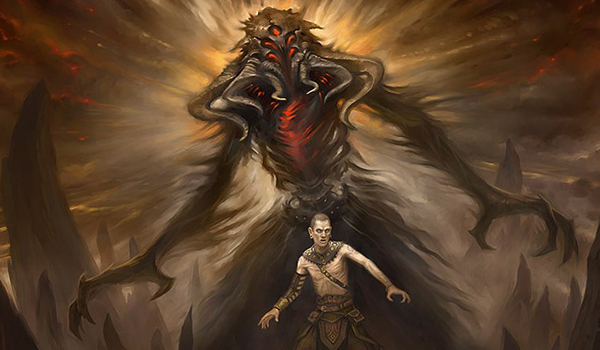
Fast forward 13 months. They used to laugh. They used to jeer. Now, they lie defeated on the roadside, their decks broken in their arms. Death's Shadow has come, and it has had its revenge.
[wp_ad_camp_1]
Then
Death's Shadow Zoo, by Fabrizio Anteri (14th, GP Copenhagen)
At GP Copenhagen in the summer of last year, Fabrizio Anteri first put this archetype on the map with his Top 16 finish, proving definitively to the world that this deck was capable of strong results. Only seen before in deck tech videos on Channel Fireball or the depths that were Magic Online Daily results, Anteri’s finish planted the seed that would eventually grow into the evolved Death's Shadow Zoo we see today. To more accurately understand the intricacies of the archetype’s current form, we must first analyze how it came to be.
First, Anteri moved away from the playset of Steppe Lynx that most other lists were using. This is what I said in my article last June, and in my opinion it remains true today:
Steppe Lynx is a powerful beater, but only on turn one. We only play 16 lands, and while sometimes we cantrip into additional lands and flood out, other times we only see one or two lands all game. This often leaves Lynx as a 0/1 past the third turn. Also, while the goal of our deck is to actively cause pain primarily through our manabase, supporting four different color one-drops (Death's Shadow, Wild Nacatl, Monastery Swiftspear, Steppe Lynx) is difficult, especially with one-land hands. Dropping Lynx means we only need white in the maindeck to pump Wild Nacatl, and playing Kird Ape makes Stomping Ground the “best” turn one land for most hands.
To elaborate further, our gameflow often plays out in such a way that we are casting red and green spells on turn one (Wild Nacatl/Kird Ape/Monastery Swiftspear) and black spells on subsequent turns (Thoughtseize/Death's Shadow). 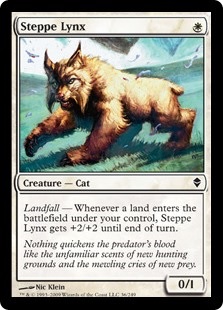 While this isn’t always the case (Thoughtseize into Death's Shadow hands, or hands with no black spells at all), generally we can plan on these common color requirements when sequencing our lands.
While this isn’t always the case (Thoughtseize into Death's Shadow hands, or hands with no black spells at all), generally we can plan on these common color requirements when sequencing our lands.
As a result, Stomping Ground is often the best turn one land to fetch, as it casts most of the threats in our hand and makes Wild Nacatl a 2/2 and Kird Ape a 2/3. This lets us fetch Godless Shrine second, to give us access to black mana for the rest of our spells and white mana for Wild Nacatl’s third point of P/T and various sideboard spells.
With Steppe Lynx in our deck, our land sequencing must change, as we’re forced to play Steppe Lynx as soon as possible. This means we are forced to fetch either Temple Garden or Godless Shrine on turn 1 and hope to pair them with Blood Crypt and Stomping Ground respectively. This is fine, except in the very real scenario where we only have access to one land. By forcing ourselves to fetch a shock that can tap for white, we’ve effectively cut ourselves off from casting a third of our threats, be they black, red, or green. Without Steppe Lynx, we’re able to turn one fetch a shockland that will always let us cast two thirds of the threat in our deck. This grants some much needed consistency.
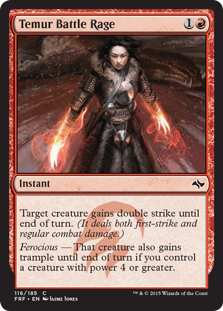 The downside, of course, is that we have to play Kird Ape, but this isn’t really a big deal when we factor in the consistency. Sure, we lose out on the ability to swing with a 4/5 on turn two, along with the potential for the prized turn-two “kill” (Steppe Lynx, second fetch, Temur Battle Rage and double Mutagenic Growth to deal 16), but in return we get a much smoother manabase and fewer nightmare situations where our spells in hand don’t line up with our lands on the table.
The downside, of course, is that we have to play Kird Ape, but this isn’t really a big deal when we factor in the consistency. Sure, we lose out on the ability to swing with a 4/5 on turn two, along with the potential for the prized turn-two “kill” (Steppe Lynx, second fetch, Temur Battle Rage and double Mutagenic Growth to deal 16), but in return we get a much smoother manabase and fewer nightmare situations where our spells in hand don’t line up with our lands on the table.
At the time of Anteri’s finish, the Thoughtseize/Lightning Bolt debate was raging in Death's Shadow Zoo circles. In a field full of Splinter Twin, Grishoalbrand, Living End, Amulet Bloom, and control decks, Lightning Bolt was often dead while Thoughtseize was instrumental in disrupting the opponent long enough for us to “get there.” On the other hand, Burn, Infect, Affinity and Abzan Company still existed, and some manner of interaction was often required. Anteri’s finish strongly suggested that Thoughtseize allowed for the most/best interaction in the highest percentage of matchups, and for the most part settled the dispute and homogenized most of the variants.
Vines of Vastwood as a two-of was considered uncuttable last year, as Splinter Twin’s presence in the format demanded some form of interaction both offensively and defensively. Twin (the archetype) existed as one of the most “interactive” decks in the format that Zoo needed to worry about---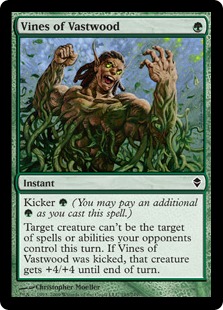 thus we see Vines of Vastwood used to protect our threats, but also used offensively to fight Splinter Twin (the card) from successfully pairing with Deceiver Exarch.
thus we see Vines of Vastwood used to protect our threats, but also used offensively to fight Splinter Twin (the card) from successfully pairing with Deceiver Exarch.
As Splinter Twin was the de facto “best deck” in the format, most other archetypes had creature interaction maindeck as well, such as Path to Exile out of Abzan Company, or Vapor Snag alongside Dismember out of Merfolk. While half the field contained polarized, non-interactive combo decks that Death's Shadow Zoo easily dominated, the other half contained archetypes prepared to interact cheaply with opposing creatures. In this sense, Vines of Vastwood was sometimes clunky but undoubtedly necessary.
Finally, the sideboard of Summer ’15 Death's Shadow Zoo shows a focused attempt to shore up a few main matchups, in particular Affinity, Burn, and Twin. We see multiple copies of a few main spells (rather than a diverse mix of sideboard options). This suggests, but does not prove, a “rough” approach to sideboarding along with a desire to find our sideboard spells consistently in post-board games. This is often the case with aggressive decks without access to selection (think Affinity or Burn) that need to find their heavy-hitting sideboard spells quickly and can’t afford a diverse mix of situational answers.
Now
Death's Shadow Zoo, by Trevor Holmes
Now we come to the present. Above is the version I’ve been playing to consistent success online, with only a few minor changes from the stock list.
Death's Shadow Zoo of Summer ’16 exists in a few variations, namely with Steppe Lynx or without. If you’ve watched me stream in the past, or took any hints from my previous few paragraphs above, you know my opinion on Steppe Lynx, so I won’t speak on that further. 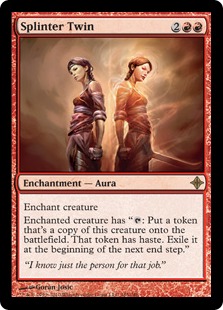 Still, the debate rages on, with both versions experiencing success, so I don’t think it matters too much. I will say that if it’s more consistency you desire, the lists that forego Steppe Lynx should be the ones you pursue, while if you’re looking for more explosive power, Steppe Lynx is probably where you want to be. It is worth noting that having Steppe Lynx does put you at a slight advantage in the mirror, provided it actually helps you and isn’t dead past the third turn. More testing is needed to determine if access to Steppe Lynx really swings the matchup one way or the other, but for now, I haven’t been missing it.
Still, the debate rages on, with both versions experiencing success, so I don’t think it matters too much. I will say that if it’s more consistency you desire, the lists that forego Steppe Lynx should be the ones you pursue, while if you’re looking for more explosive power, Steppe Lynx is probably where you want to be. It is worth noting that having Steppe Lynx does put you at a slight advantage in the mirror, provided it actually helps you and isn’t dead past the third turn. More testing is needed to determine if access to Steppe Lynx really swings the matchup one way or the other, but for now, I haven’t been missing it.
With Splinter Twin’s exodus from the format, followed subsequently by Amulet Bloom and Eldrazi, Modern is an entirely different landscape compared to last summer. Gone is the need for maindeck interaction to disrupt a turn-four Splinter Twin on Deceiver Exarch, and with its removal the average amount of interaction in Modern has decreased.
In its place, decks have become more streamlined and linear, focused on effectively accomplishing whatever busted goal they desire as quickly as possible. Where before archetypes like Abzan Company, Affinity, and Merfolk would be forced to dilute their deck with spells that interact with opposing creatures, now they can just execute Plan A match after match as fast as possible. This might sound bad for us, as in this sense the format has gotten “faster,” but overall this is great for Death's Shadow Zoo, as we now get to be faster as well.
Without having to worry about protecting our creatures from so much interaction (or prevent our opponent from combo-killing us on turn four) we can do the same as everyone else: put our head down and ignore our opponent’s side of the table. 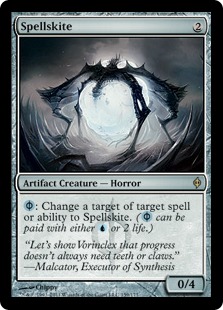 Hey, if you can’t beat 'em, join 'em, except by joining them we are also beating them. We don’t care if Tron plays a Karn on turn three, because they can only kill one creature and are dead the next turn anyways. We don’t care if Jeskai Nahiri casts their namesake, as besides Path to Exile all of their interaction is hopelessly clunky compared to our threats, and our four Mutagenic Growth work wonders to negate their Lightning Bolts for free.
Hey, if you can’t beat 'em, join 'em, except by joining them we are also beating them. We don’t care if Tron plays a Karn on turn three, because they can only kill one creature and are dead the next turn anyways. We don’t care if Jeskai Nahiri casts their namesake, as besides Path to Exile all of their interaction is hopelessly clunky compared to our threats, and our four Mutagenic Growth work wonders to negate their Lightning Bolts for free.
Before we had to worry about interaction from everyone and were forced to bring in Dismember for possible Spellskites out of any matchup. Now everyone is just looking to go as fast as possible, but none of them can go as fast as us. Affinity is the only deck in the format that can empty their hand as fast as us, and Burn can kill us quickly because we do 40% of the work for them, but everyone else is just a half turn too slow. They “could” push us out of the format by playing a bunch of Spellskite and Dismember, but doing so would force them to lose too many points in other matchups.
Thus, Death's Shadow Zoo has carved out a niche for itself in the metagame, putting up consistent numbers on MTGO, while the rest of the format looks on in frustration, knowing they “could” hate us out but would lose across the board if they did so.
With more pilots picking up the deck a few general areas of consensus have emerged, primary among them being Lightning Bolt and the sideboard Forest.  Almost everyone in the format plays two Bolt, as even though Thoughtseize is better overall, Bolt is necessary to slow down the rest of the aggressive decks in the format. When Affinity, Infect, Burn, and the mirror (and Merfolk/Abzan Company to a lesser extent) make up the majority of the field, having Lightning Bolt is a must and four Thoughtseize is a little greedy---hence the consensus 3/2 split. The sideboard Forest exists to combat the best two cards against us (Path to Exile and Ghost Quarter) which are legitimate known paths to victory against us now that we aren’t catching people off guard anymore.
Almost everyone in the format plays two Bolt, as even though Thoughtseize is better overall, Bolt is necessary to slow down the rest of the aggressive decks in the format. When Affinity, Infect, Burn, and the mirror (and Merfolk/Abzan Company to a lesser extent) make up the majority of the field, having Lightning Bolt is a must and four Thoughtseize is a little greedy---hence the consensus 3/2 split. The sideboard Forest exists to combat the best two cards against us (Path to Exile and Ghost Quarter) which are legitimate known paths to victory against us now that we aren’t catching people off guard anymore.
Burn is still an atrocious matchup, and we have a tough time winning unless we can play a Death's Shadow guaranteed on turn two (even then we need them not to have Deflecting Palm). Faith's Shield is a great piece of tech that gives us most of what Apostle's Blessing could provide, while sometimes letting us Falter our opponent’s board or Angel's Grace ourselves in a pinch.
Besides Burn, we’re happy to play almost anything except Jund, although the format is in a place where every deck is fast enough to beat us if we stumble, and we still tend to stumble a significant portion of games. Players that can afford it have been playing a singleton Tarmogoyf in an attempt to provide some more consistent power, and this is probably a move you should make if you can, though I haven’t tested it out myself.
Conclusion
Death's Shadow Zoo is, and always has been, a fun, powerful, explosive archetype that rewards tight play and can blow decks right out of the water. Results may vary, and some interactions might seem non-intuitive at first, like when to Mishra's Bauble ourselves to see if we want to fetch away our top card before casting Gitaxian Probe, but these lessons are quickly learned and the difference they make are easily seen. If you want to be unfair in Magic, enjoy attacking with creatures, and don’t like Infect, auras, or 0/2’s for 0, then this archetype is for you.
Sideboarding is an art with this deck, and one I’m still learning, even though I’ve been playing this archetype off and on in various permutations for over a year now. I’m hesitant to approach the topic in just a few paragraphs, as I feel it’s intricate enough to warrant an entire article itself. Normally I refrain from doing “sideboarding guides” as I believe the process should be more fluid than a rigid guide suggests, but perhaps if there’s enough interest this could be a future article topic?
Let me know in the comments below, and be sure to stop by my stream if you want to see this deck in action! Thanks for reading, and I’ll see you next week.
Trevor Holmes
The_Architect on MTGO
Twitch.tv/Architect_Gaming
Twitter.com/7he4rchitect




Reading your decklist I was somewhat confused until I realized that you have the wild nacatls in the “lands” section. Might want to change that.
Done! Thanks
Loving the Rancor tech. Good, informative article.
Oh boy. Super glad to see Trevor comment on this sweet deck. I have so many questions though. May I pick your brain?
Um, yes? That’s what comments are for! Unless I’m missing an invisible Kappa 🙂
I have to admit, I was initially a skeptic on Zooicide, but the archetype has proven its mettle, and has to be considered a real Modern deck. I think the removal of Steppe Lynx was a big step forward in making that happen. The deck presented has a bug that makes it look a bit odd (namely that Wild Nacatl somehow ended up in the lands section), but it looks very good to me.
I do find myself wondering (now that Vines of Vastwood is no longer part of the 75) whether the deck wants the 4th Become Immense or not. Is the 1-of Rancor truly that more potent? And if so, would you consider a 2nd copy?
Rancor isn’t “great” in the sense that it’s really there to help overcome a weakness against tokens, which is a weakness that we often don’t run into that much. As a result, I end up boarding it out a lot, as there are many other options that feel like they do “more” for the one mana investment.
As for the 4th Become Immense, we’re often cutting some number of the combo in most post-board games in response to opponents bringing in more removal, plus we want to make room for sideboard options without reducing our deck’s consistency by boarding out cantrips. I have never wanted the 4th copy and would gladly play another creature or Lightning Bolt before it.
Thanks!
Trevor
All fair points. The deck looks quite good as presented then.
I wasn’t playing Magic, let alone modern, when the original article came out. After reading both today, honestly I want to play the deck! I need an aggro deck for modern on days I don’t feel like playing Tron. Gotta buy fetchlands some time anyways.
1) What are your views on the Grixis shell of this deck that are popping up?
2) Is Kiln Fiend not good enough for this deck?
3) I think i could fit in 2x Bedlam Reveler into this deck and make it work (probably more the Grixis shell as it has more spells), what do you think?
Hey Trevor,
What are your thoughts on cutting white from the deck and replacing Wild Nacatl Gnarlwood Dryad? I was wondering if the upside of a slightly more consistent mana base and the fact that Dryad can keep attacking into larger creatures unimpeded (thanks to deathtouch – which also synergies extremely well with trample) would be worth it. Thanks!
If we were to slot in a Tarmogoyf, what would it replace, and do we only want the 1?